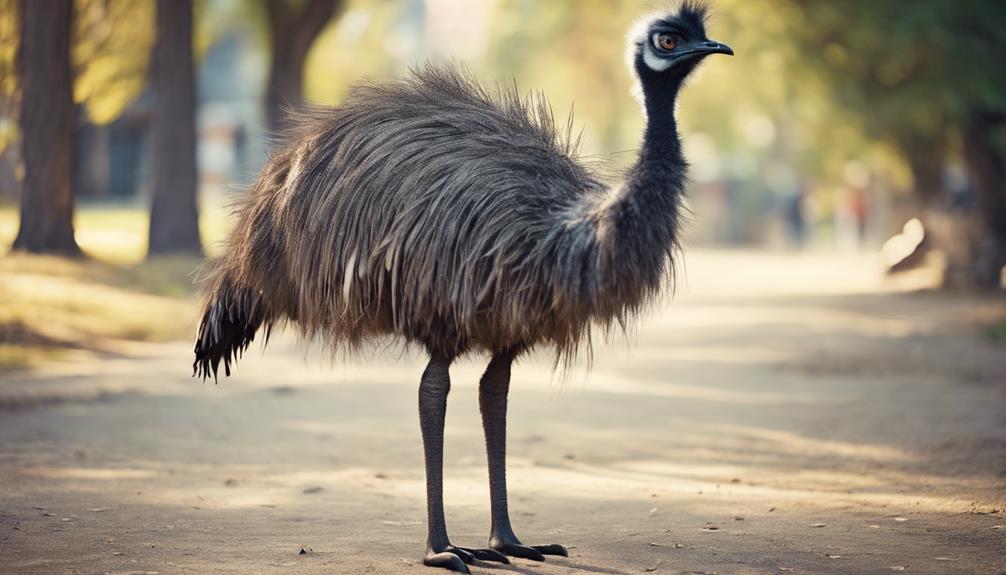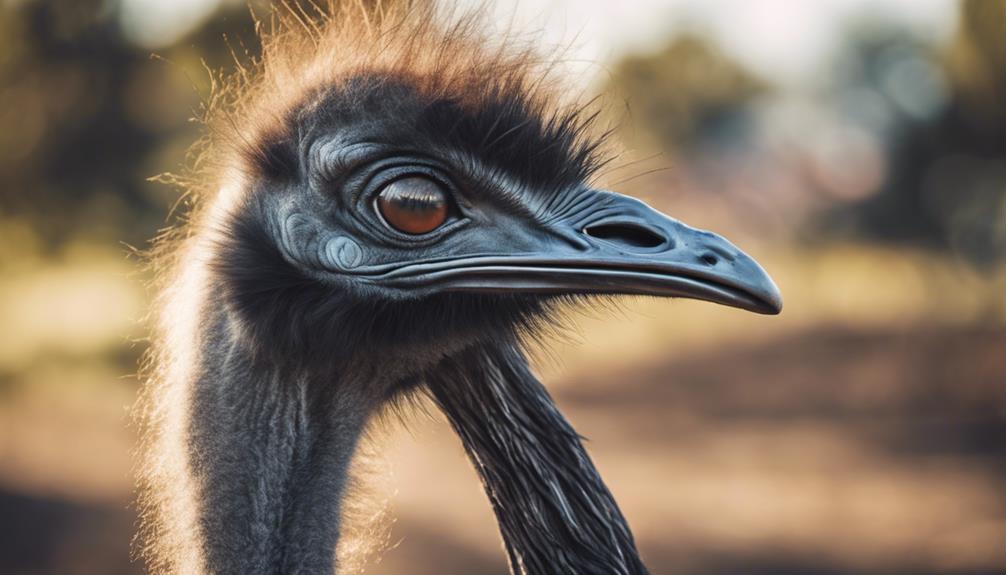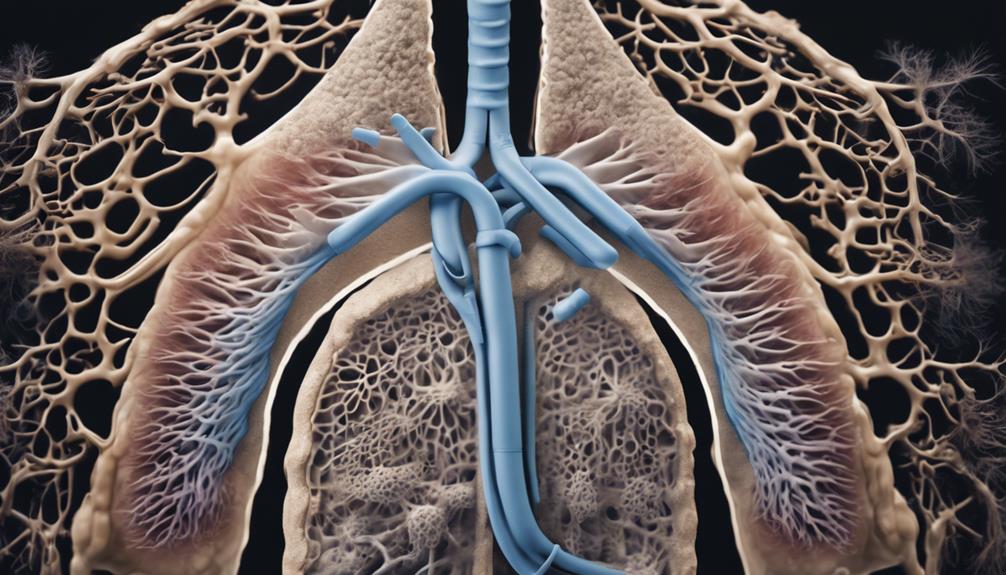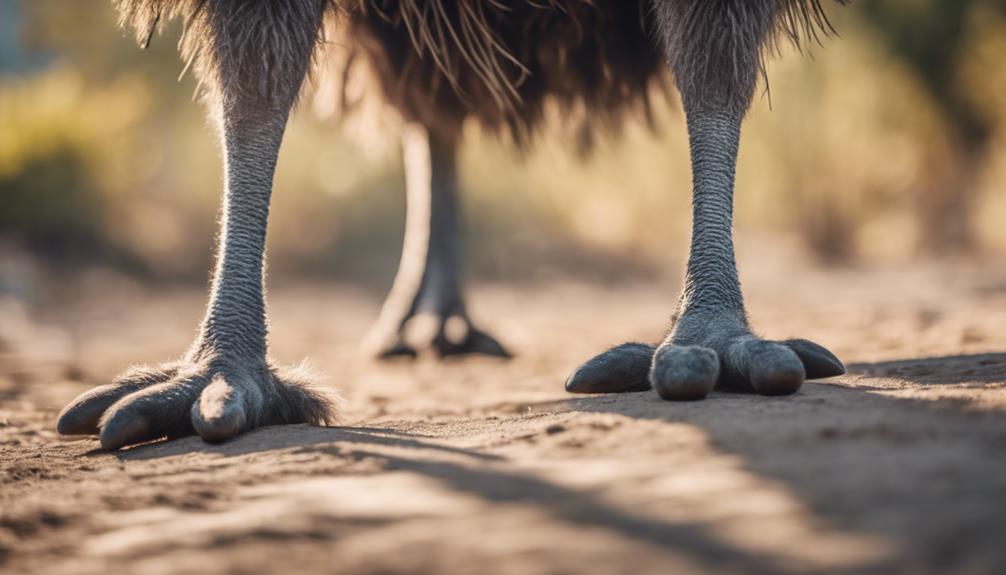
You may think you know about emus, but have you truly explored the intricacies of their anatomy? The structure of an emu is not just a simple arrangement of bones and muscles; it is a finely tuned masterpiece of nature's design. From their impressive legs to their keen eyes and beak, every detail serves a vital purpose in their survival. But what lies beneath the surface of an emu's physical form is a fascinating journey waiting to be uncovered, revealing the secrets of their remarkable adaptation to the harsh Australian environment.
Key Takeaways
- Emus have long, powerful legs for speed and support.
- Their lightweight bones are airy and filled with cavities.
- Emus possess strong, muscular legs and sharp claws.
- They have a flexible neck and spine for agile movements.
- Emus feature a specialized digestive system for efficient nutrient absorption.
Emu Physical Characteristics

Emus possess distinctive physical characteristics that make them easily recognizable in their natural habitat. One of the most striking features is their long neck, which can reach up to one meter in length. This elongated neck allows emus to forage for food in high places, giving them a powerful advantage in spotting predators or potential threats from afar. Their sharp, piercing eyes are strategically positioned on the sides of their head, providing them with a wide field of vision to detect movement in their surroundings quickly.
The emu's body is covered in soft, dense feathers that range in color from brown to gray, blending seamlessly with the arid landscape they inhabit. Their strong, muscular legs are built for speed and endurance, enabling them to reach speeds of up to 30 miles per hour when necessary. The powerful three-toed feet are equipped with sharp claws, ideal for defense and digging for food in the harsh Australian terrain.
Emu Skeletal Structure
Beneath the outward appearance of the emu lies a complex and sturdy skeletal structure that's essential for its survival and mobility in its natural environment.
- Long and Powerful Legs: The emu's skeletal system is characterized by its long and robust legs, which provide the necessary support for its large body and enable swift movements across vast distances. The leg bones are designed to withstand the immense forces exerted during running and kicking, contributing to the emu's remarkable speed and agility.
- Lightweight and Airy Bones: Despite its size, the emu possesses lightweight bones filled with air cavities, reducing the overall weight of its skeleton without compromising strength. This adaptation aids in enhancing the bird's efficiency in movement and minimizes energy expenditure during locomotion.
- Flexible Neck and Spine: The emu's skeletal structure includes a flexible neck and spine, allowing for a wide range of motion essential for activities such as foraging, grooming, and vigilance. The ability to bend and twist its neck and spine with ease enhances the emu's overall adaptability and survival in its challenging habitat.
Emu Muscular System

The intricate skeletal structure of the emu seamlessly interfaces with its muscular system, forming a harmonious network of strength and agility that powers the bird's movements and actions in its environment. Emus possess powerful muscles that enable them to run at speeds of up to 30 miles per hour, making them formidable creatures in their habitat. The primary muscles responsible for this remarkable locomotion are the powerful leg muscles, especially the gastrocnemius and quadriceps, which contract with incredible force to propel the emu forward with each stride.
In addition to their impressive leg muscles, emus also have well-developed pectoral muscles that allow them to flap their wings with strength and precision. These muscles, along with the deltoids and triceps, provide the emu with the ability to maintain balance, maneuver swiftly, and even defend themselves if necessary. The muscular system of the emu is finely tuned and optimized for speed, agility, and power, reflecting the bird's resilience and adaptability in its natural environment.
Emu Digestive System
Nestled within the emu's body lies a complex and efficient digestive system, meticulously designed to extract vital nutrients from its diet for sustenance and energy. This system is a marvel of biological engineering, allowing the emu to thrive in its environment with remarkable efficiency.
- Specialized Digestive Organs: The emu possesses a specialized digestive tract that includes a crop, proventriculus, gizzard, small intestine, and ceca. Each of these organs plays a crucial role in breaking down food and absorbing nutrients effectively.
- Fermentation Process: The emu's digestive system utilizes fermentation in its ceca to further break down fibrous plant material, allowing for the extraction of additional nutrients that would otherwise be inaccessible. This fermentation process is vital for the emu to derive energy from its primarily plant-based diet.
- Efficient Nutrient Absorption: The emu's digestive system maximizes the absorption of essential nutrients through the intricate structure of its intestines. This efficient nutrient absorption ensures that the emu can derive the necessary sustenance to support its active lifestyle and survival in the wild.
Emu Respiratory System

Within the emu's intricate anatomy, the respiratory system functions as a vital mechanism for oxygen intake and carbon dioxide release. Emus possess a highly efficient respiratory system adapted to their unique needs. The process begins as you inhale air through your nostrils, which then travels down the trachea. The trachea branches into the bronchi, which further divide into smaller bronchioles, eventually reaching the air sacs where gas exchange occurs.
Emus have a complex system of air sacs that extend throughout their body, allowing for a continuous flow of air during both inhalation and exhalation. This design ensures a constant supply of oxygen to meet the high energy demands of these magnificent creatures. The oxygen-rich air is then circulated through the bloodstream, providing essential nutrients to the emu's cells and tissues.
As you exhale, the carbon dioxide-rich air is expelled from the air sacs and released back into the environment. This efficient process of respiration is crucial for sustaining the emu's active lifestyle and powerful physique.
Emu Circulatory System
Emu's circulatory system works in tandem with its respiratory system, ensuring efficient oxygen delivery throughout its body for sustained activity and vitality. This system is a marvel of evolutionary design, optimizing oxygen transport to meet the demands of the emu's active lifestyle.
Three key components of the emu's circulatory system are:
- Large Heart: The emu boasts a powerful heart that efficiently pumps oxygen-rich blood to all parts of its body. This muscular organ ensures a rapid circulation, supporting the bird's high energy levels and endurance.
- High Red Blood Cell Count: Emus have a high concentration of red blood cells, enhancing their blood's oxygen-carrying capacity. This abundance of red blood cells enables the emu to extract oxygen from the air more effectively, providing the necessary fuel for its physical activities.
- Efficient Blood Vessels: The emu's circulatory system is equipped with a network of well-developed blood vessels that facilitate the swift and smooth flow of oxygenated blood. This intricate system ensures that oxygen reaches every tissue and organ, promoting optimal performance and vitality in the majestic emu.
Emu Nervous System

The intricate network of neurons in the emu facilitates rapid communication between various body parts, allowing for swift responses to external stimuli. The emu's nervous system consists of a complex web of nerves that span from the brain down the length of the body, branching out to reach every muscle and organ. This network enables the emu to react quickly to its environment, whether it's sensing danger or seeking food.
The emu's brain, though relatively small compared to its body size, is highly developed, especially in areas responsible for processing sensory information and coordinating movement. This allows the emu to navigate its surroundings with precision and agility. The spinal cord, running along the backbone, acts as a superhighway for signals traveling between the brain and the rest of the body, ensuring rapid communication and response times.
Emu Reproductive System
Positioned deep within the abdomen of the emu lies a meticulously organized reproductive system essential for the perpetuation of the species. This intricate system is finely tuned to ensure the continuation of the emu lineage with precision and efficiency.
- Reproductive Organs: The emu possesses a pair of ovaries responsible for producing eggs, which are then fertilized by sperm from the male emu. The male emu, on the other hand, has testes that produce sperm for fertilization.
- Egg Development: Once fertilization occurs, the female emu's oviduct plays a crucial role in the development of the egg. This process involves the sequential formation of the egg's various components, ultimately leading to the creation of a viable offspring.
- Mating Rituals: Emus exhibit complex mating rituals where the male attracts the female through elaborate displays of behavior. These rituals are essential for successful mating and the continuation of the species.
Emu Feathers and Plumage

Amidst the emu's intricate anatomy, the feathers and plumage play a vital role in various aspects of its survival and behavior. Emus are adorned with two types of feathers: soft down feathers close to the skin and long, coarse feathers that form their distinctive plumage. These feathers serve multiple functions, acting as insulation to regulate body temperature, provide protection against the elements, and aid in communication and courtship displays.
The emu's plumage is primarily brown in color, helping it blend into its natural surroundings and offering camouflage from predators. The arrangement of feathers also plays a crucial role in thermoregulation, allowing the bird to adjust its insulation by altering the position of its feathers. During mating season, the male emu's feathers become even more vital as they perform elaborate displays to attract females. The fluttering and drumming of their wings create visual and auditory signals that showcase the male's fitness and vigor, making the plumage an essential tool in the emu's reproductive success.
Emu Beak and Eyes
Nestled atop the emu's elongated neck, the prominent beak and keen eyes serve as essential tools for both survival and communication in its natural habitat.
- Beak Structure: The emu's beak is robust and pointed, ideal for foraging and capturing prey. Its sharp tip allows for precise pecking, while the strong, slightly curved shape aids in tearing vegetation and digging for roots and insects.
- Vision: The emu possesses remarkable binocular vision, with each eye situated on the sides of its head, providing a wide field of view. This acute eyesight allows the emu to detect predators from afar and spot potential food sources with clarity, contributing to its survival in the vast Australian landscape.
- Eye Communication: Beyond their role in hunting and vigilance, the emu's eyes are instrumental in non-verbal communication. During courtship displays or territorial confrontations, the emu's eyes convey dominance, fear, or submission through subtle movements and dilations, reflecting the bird's emotional state and intentions with precision.
Emu Legs and Feet

Emus exhibit remarkable adaptations in their powerful legs and feet, crucial for their mobility and survival in their natural environment. Their legs are long, muscular, and designed for rapid locomotion. The emu's feet are uniquely structured with three toes, each tipped with a sharp claw, aiding in defense and foraging. These impressive appendages allow the emu to reach speeds of up to 30 miles per hour, making them formidable runners and evaders.
The emu's strong legs are perfectly suited for covering vast distances in search of food and water. Their robust thigh muscles provide the necessary power for swift movement, enabling them to navigate varied terrains with ease. The tendons in their legs act as powerful springs, propelling the emu forward with each stride. Additionally, the emu's feet are adapted to distribute weight evenly, reducing strain during long journeys.
Emu Adaptations for Survival
Among the various adaptations that contribute to the emu's survival in its environment, its remarkable physiological features play a crucial role. These adaptations have been honed through evolution to ensure the emu's dominance in its habitat.
- Efficient Thermoregulation: The emu possesses a specialized respiratory system that allows for increased oxygen uptake during intense physical activity, aiding in regulating body temperature in the harsh Australian outback.
- Powerful Legs: The emu's strong, muscular legs enable swift running speeds of up to 30 miles per hour, essential for evading predators and covering vast distances in search of food and water.
- Camouflaged Plumage: The emu's cryptic coloration and feather patterns provide excellent camouflage amidst the scrubby landscape, aiding in both predator avoidance and successful hunting.
These adaptations collectively equip the emu with the tools necessary to thrive in its challenging environment, showcasing the power of natural selection in sculpting a creature perfectly suited for survival in the Australian wilderness.
Frequently Asked Questions
How Fast Can an Emu Run?
Emus, powerful runners, can reach speeds up to 30 miles per hour. Their long legs and strong muscles allow them to cover great distances swiftly. Observing an emu running showcases nature's impressive speed and agility.
What Do Emus Eat in the Wild?
In the wild, emus primarily eat plants like leaves, fruits, seeds, and even insects. Their diet varies based on seasons and availability, showcasing their adaptability to different environments. Emus are true omnivores, thriving on diverse food sources.
Do Emus Have Any Predators?
In the wild, emus face threats from predators like dingoes, eagles, and feral pigs. These predators hunt emus for food, posing a serious risk to the survival of these flightless birds in their natural habitats.
How Long Do Emus Live in Captivity?
In captivity, emus can live up to 20 years. Proper diet, habitat, and veterinary care are crucial for their longevity. Emus thrive in well-managed environments, exhibiting robust health and vitality when given optimal conditions.
Can Emus Swim?
Yes, emus can swim. They are proficient swimmers, using their powerful legs and streamlined bodies to navigate water. Emus have been known to swim across rivers and water bodies as a means of crossing obstacles.
Conclusion
As you marvel at the intricate anatomy of an emu, remember that despite their impressive adaptations, they still fall prey to the stealthy tactics of their predators.
So next time you witness an emu's swift running or powerful beak in action, appreciate the delicate balance between strength and vulnerability in the natural world.
The survival strategies of these magnificent creatures are a constant reminder of the harsh realities of the wild.





